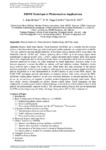
Please use this identifier to cite or link to this item:
http://ricaxcan.uaz.edu.mx/jspui/handle/20.500.11845/793Full metadata record
| DC Field | Value | Language |
|---|---|---|
| dc.contributor | 6207 | es_ES |
| dc.contributor.other | https://orcid.org/0000-0002-7081-9084 | es_ES |
| dc.coverage.spatial | Global | es_ES |
| dc.creator | Sajo Bohus, Laszlo | - |
| dc.creator | Vega Carrillo, Héctor René | - |
| dc.creator | Singh, Vishwanath | - |
| dc.date.accessioned | 2019-03-19T15:17:06Z | - |
| dc.date.available | 2019-03-19T15:17:06Z | - |
| dc.date.issued | 2015-06 | - |
| dc.identifier | info:eu-repo/semantics/publishedVersion | es_ES |
| dc.identifier.issn | 1662-9779 | es_ES |
| dc.identifier.uri | http://localhost/xmlui/handle/20.500.11845/793 | - |
| dc.identifier.uri | https://doi.org/10.48779/xp0g-wt47 | es_ES |
| dc.description.abstract | Passive Solid State Nuclear Track Detectors (SSNTDs) are a versatile tool for neutron studies as has been shown long ago and several good quality materials are commercially available. They are useful for charged particle detection in the linear energy transfer (LET) range above the threshold value of ~10 keV μm-1. Linacs, operating above 6 MeV up to the energy region where radiotherapy is applied usually up to ~25MeV, induce unwanted photo-neutron field; their spectra shows two components due to reaction dynamics based on evaporation and knock-on mechanisms. Neutrons produced by Linacs are often neglected in health application; however, today it has become necessary to assess the effect on patient, staff and radiation workers. Radiation studies using SSNTDs play a major role in this case. Other fields also take advantage of the passive detectors properties; in fact they are employed with success to measure neutron signals relevant for plasma diagnostics as it was demonstrated at the RFX facility as part of the ITER project. The PADC-NTD techniques provide information on external neutron field values around the RFXinstallation during pulsed operation. In any case, converter materials, as charged particles from (n, p) and (n, α) reactions, are required to produce neutron fingerprints through latent tracks. These once etched provide information on neutron fluence spatial values. Track histograms are then employed to determine photo-neutron induced damage in materials as well as radiation dose to both patient and professionally exposed workers. The estimated neutron fluence that can be determined by NTM covers a large range of values, the largest being above 1010 (± 12%) neutrons/cm2. | es_ES |
| dc.language.iso | eng | es_ES |
| dc.publisher | Trans Tech Publications Inc | es_ES |
| dc.relation.uri | generalPublic | es_ES |
| dc.rights | Atribución-NoComercial-CompartirIgual 3.0 Estados Unidos de América | * |
| dc.rights.uri | http://creativecommons.org/licenses/by-nc-sa/3.0/us/ | * |
| dc.source | Solid State Phenomena Vol, 239, junio 2015, pp 180-214 | es_ES |
| dc.subject.classification | CIENCIAS FISICO MATEMATICAS Y CIENCIAS DE LA TIERRA [1] | es_ES |
| dc.subject.other | Passive Detectors | es_ES |
| dc.subject.other | Photo-neutrons | es_ES |
| dc.subject.other | Radiotherapy | es_ES |
| dc.subject.other | SSNTDs | es_ES |
| dc.subject.other | Linac | es_ES |
| dc.title | SSNTD Technique in Photo-neutron Applications | es_ES |
| dc.type | info:eu-repo/semantics/article | es_ES |
| Appears in Collections: | *Documentos Académicos*-- UA Ciencias Nucleares | |
Files in This Item:
| File | Description | Size | Format | |
|---|---|---|---|---|
| SSNTD Technique in Photo-neutron Applications2.pdf | 1,56 MB | Adobe PDF |  View/Open |
This item is licensed under a Creative Commons License
